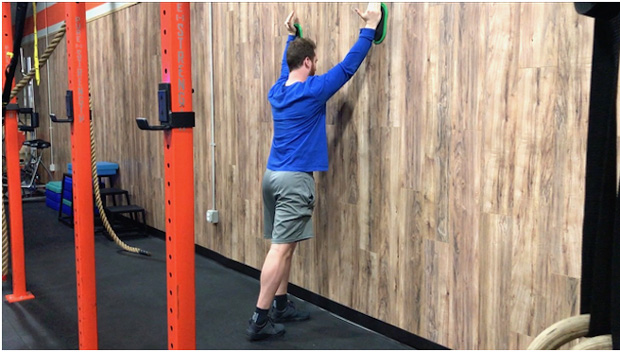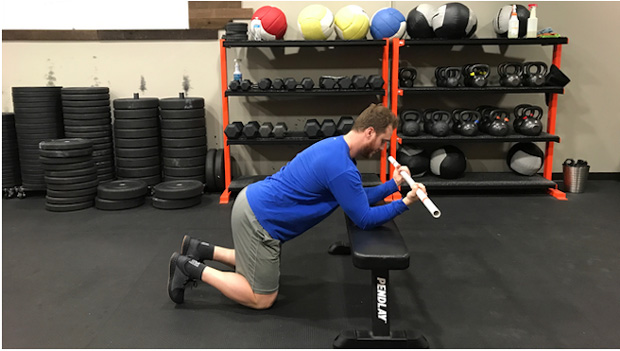| 9 Components of a Fantastic Arm Care Program for Pitchers |
| By: Brett Cummings
Provided by: STACK A pitcher has to take care of their arm. If you clicked on this article, you likely know that much. My goal with this piece is to make you re-evaluate your arm care program. It's important to remember the body is one big chain, and one bad link in that chain can cause negative effects that reverberate throughout the body. With that in mind, here are nine things a fantastic arm care program should accomplish. 1. Attain Proper Posture If you take away anything from this article, make it this. Posture is the biggest indicator of movement faults and potential injuries. Your postural position lays the groundwork for everything else I will talk about in this article. If you can't stand in a good position, you can't expect to go through powerful athletic movements (such as pitching a baseball) in a good position. Prolonged poor posture will eventually lead to movement faults, which can lead to injuries. Performing arm care work with bad posture is like washing your car with dirty water - it may help get some of the most obvious mud off the car, but you're not addressing the root of the problem. 2. Learn How to Breathe Breathing and a focus on how to breathe correctly is beginning to make its way into strength and conditioning programs. Baseball athletes often have an issue of hanging out in a extension-based posture. One of the best things to counteract this is to incorporate proper breathing patterns. Teaching proper breathing can help reduce rib flare and lumbar hyper-extension. Both of these can negatively affect ball-and-socket positioning in the shoulder, putting the athlete at an increased risk for injury. 3. Restore Scapular Upward Rotation One attribute of every healthy thrower is good and proper scapular upward rotation. Unfortunately, as throwing volume increases, scapular upward rotation decreases. It's necessary to take time off from throwing to address this issue and incorporate exercises that help restore good upward rotation. Wall Slides, an exercise depicted in the photos below, are great for this:
4. Bring the Pelvis Back to Neutral This point refers back to Nos. 1 and 2, but the pelvis and how it's positioned can tell a lot about the future health of a baseball player. As the season progresses, the majority of baseball players will slip into an anterior tilted position. Think of this as someone trying to poke their butt out. This poor positioning can cause a number of issues, from lumbar hyper-extension to poor scapular positioning. A poorly positioned joint can negatively effect joints below and above it, so be sure to address poor pelvis positioning. This article details several steps an athlete can take to battle anterior pelvic tilt. 5. Make the Lats Strong and Flexible Baseball players have a love/hate relationship with lats. On one hand, you need your lats to help transfer force from your lower body to your upper body. The best pitchers are able to really activate their lats during their delivery. On the other hand, overly powerful lats can put a pitcher's lower back and shoulders into a vulnerable position. Lats must be strong and active, but also flexible and mobile. The lats must be addressed if you're looking to optimize your performance and prevent injury. Bench Thoracic Spine Mobilizations, shown in the photos below, promote thoracic extension and produce a good stretch in the lats:
6. Strengthen the Cuff and Increase Active Range of Motion Shoulder external rotation and shoulder internal rotation are what most people think when it comes to traditional arm care. They're very important, but I think we as coaches and players must also appreciate what occurs during the season. That's when external rotation is often gained and internal rotation is frequently lost. More external rotation is not necessarily bad, but if too much occurs, the throwers will get away from their active Range of Motion (ROM) and dip into their passive ROM. This is where the rate of injury can increase. Work on both external rotation and internal rotation to not only strengthen the rotator cuff, but to increase the active range of motion in both movements. This piece offers a great guide for assessing and improving your own shoulder mobility. 7. Establish a Solid Overhead Range of Motion Screening overhead flexion can tell us a lot about any athlete - especially baseball players. If you can't go overhead without compensation patterns, you cannot throw a baseball without compensation patterns. Limited overhead range of motion can mean a lack of thoracic spine mobility, the inability to posteriorly tilt the scaps, tight lats, or tight soft tissue in the front of the body (such as the pecs/deltoids). All of these issues can lead to an unhealthy shoulder if not addressed before throwing starts. 8. Perform Smart Exercises Think about the exercises that set your arm up for success in relation to the other points I've brought up in this article. Instead of a Barbell Bench Press,Push-Ups might be a better option. Instead of an Overhead Barbell Press, a Half-Kneeling Single-Arm Kettlebell Press might be a better option. Understand what your entire body needs to possess for quality arm care and build your exercise selection around those needs. Does your exercise selection negatively affect things like posture, rib positioning, scapular function and positioning, pelvis position, lat function, shoulder external rotation and internal rotation, and overhead range of motion? If it does, you may want to reconsider a few things in your routine. 9. Don't Throw Year-Round It's been well documented that pitchers who throw year-round are at a much higher risk to sustain an injury. If you don't take time off, it becomes impossible to address all the issues I have outlined in this article. You can't correct upward scapular rotation if you are still throwing. Take time off to correct the imbalances and losses of motion that have accrued in your body during the season. Photo Credit: bmcent1/iStock |










